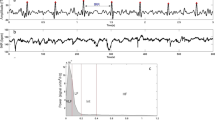Abstract
A correlation between slow-wave processes in the female–fetus system was experimentally studied and mathematically analyzed in rat fetuses retaining placental connection with the maternal organism during the final 4 days of gestation. Simultaneous recording of the physiological state’s parameters of females and fetuses revealed a relationship between the respiration and heart rate oscillations in the near-minute and multi-minute ranges. The relationship between maternal and fetal heart rates was strongest on the 17th and 20th days of gestation and somewhat weaker on the 18th–19th days. The mechanism underlying female–fetus synchronization of heart rate oscillations is unclear. There are two hypothetical possibilities: either the oscillation driver sharing similar parameters in mother and fetus, or the maternal rhythm exerting a direct influence on the fetus.
Similar content being viewed by others
References
Patrick, J., Campbell, K., Carmichael, L., and Probert, C., Influence of maternal heart rate and gross fetal body movements on the daily pattern of fetal heart rate near term, Am. J. Obstet. Gynecol., 1982, vol. 144, pp. 533–538.
Lunshof, S., Boer, K., Wolf, H., Van Hoffen, G., Bayram, N., and Mirmiran, M., Fetal and maternal diurnal rhythms during the third trimester of normal pregnancy: outcomes of computerized analysis of continuous twenty-four-hour fetal heart rate recordings, Am. J. Obstet. Gynecol., 1998, vol. 178, pp. 247–254.
Van Leeuwen, P., Geue, D., Lange, S., Cysarz, D., Bettermann, H., and Grönemeyer, D.H., Is there evidence of fetal–maternal heart rate synchronization? BMC Physiol., 2003. vol. 3, p. 2.
Van Leeuwen, P., Geue, D., Thiel, M., Cysarz, D., Lange, S., Romano, M.C., Wessel, N., Kurths, J., and Grönemeyer, D.H., Influence of paced maternal breathing on fetal–maternal heart rate coordination, Proc. Natl. Acad. Sci. USA, 2009, vol. 106, pp. 13661–13666.
DiPietro, J.A., Caulfield, L.E., Irizarry, R.A., Chen, P., Merialdi, M., and Zavaleta, N., Prenatal development of intrafetal and maternal–fetal synchrony, Behav. Neurosci., 2006, vol. 120, pp. 687–701.
Monk, C., Fifer, W.P., Myers, M.M., Sloan, R.P., Trien, L., and Hurtado, A., Maternal stress responses and anxiety during pregnancy: effects on fetal heart rate, Dev. Psychobiol., 2000, vol. 36, no. 1, pp. 67–77.
Welberg, L.A. and Seckl, J.R., Prenatal stress, glucocorticoids and the programming of the brain, J. Neuroendocrinol., 2001, vol. 13, no. 2, pp. 113–128.
DiPietro, J.A., Hilton, S.C., Hawkins, M., Costigan, K.A., and Pressman, E.K., Maternal stress and affect influence fetal neurobehavioral development, Dev. Psychology, 2002, vol. 38, pp. 659–668.
DiPietro, J.A., Kivlighan, K.T., Costigan, K.A., and Laudenslager, M.L., Fetal motor activity and maternal cortisol, Dev. Psychobiol., 2009, vol. 51, no. 6, pp. 505–512.
Jadhon, M.E. and Main, E.K., Fetal bradycardia associated with maternal hypothermia, Obstet. Gynecol., 1988. vol. 72, pt. 2, pp. 496–497.
Aboud, E. and Neales, K., The effect of maternal hypothermia on the fetal heart rate, Int. J. Gynaecol. Obstet., 1999, vol. 66, pp. 163–164.
Tanaka, M., Ikeda, T., Suzuki, T., Yakubo, K., and Fukuiya, T., A case of fetal bradycardia and sinusoid-like fetal heart rate pattern associated with maternal hypothermia, Fetal Diagn. Ther., 1995, vol. 10, no. 3, pp. 207–209.
Bekedam, D.J., Mulder, E.J., Snijders, R.J., and Visser, G.H., The effects of maternal hyperoxia on fetal breathing movements, body movements and heart rate variation in growth retarded fetuses, Early Hum. Dev., 1991, vol. 27, no. 3, pp. 223–232.
Piskunova, L.V., Chekhonatskaya, M.L., and Arenina, N.Yu., Diagnostic and prognostic significance of the analysis of variability of the cardiac rhythm in pregnant women for assessing fetal hypoxia, Saratovskii Nauchno-Med. Zh., 2010, vol. 6, pp. 540–543.
DiPietro, J.A., Irizarry, R.A., Costigan, K.A., and Gurewitsch, E.D., The psychophysiology of the maternal–fetal relationship, Psychophysiol., 2004, vol. 41, pp. 510–520.
Ivanov, P.Ch., Ma, Q.D., and Bartsch, R.P., Maternal–fetal heartbeat phase synchronization, Proc. Natl. Acad. Sci. USA, 2009, vol. 106, pp. 13641–13642.
Kuznetsov, S.V., Sisonov, V.A., and Dmitrieva, L.E., Change of character of intersystemic interactions in newborn rat pups under conditions of a decrease of central influences (urethane anesthesia), J. Evol. Biochem. Physiol., 2014, vol. 50, pp. 234–246.
Biopotentsialy mozga cheloveka. Matematicheskiy analiz (Biopotentials of the Human Brain. Mathematical analysis), Rusinov, V.S., Ed., Moscow, 1987.
Vdovichenko, N.D., Timofeeva, O.P., and Bursian, A.V., Quantitative estimation of connection of the heart rate rhythm with motor activity in rat fetuses, J. Evol. Biochem. Physiol., 2014, vol. 50, pp. 103–108.
Kulaev, B.S., Bursian, A.V., Timofeeva, O.P., Dmitrieva, L.E., Poliakova, L.A., and Semenova, Yu.O., Rhythmic processes in the developing organism and their synchronization, Zh. Evol. Biokhim. Fiziol., 1999, vol. 35, pp. 368–375.
Kuznetsov, S.V., About mechanisms of genesis, structure, and functional role of endogenous rhythms, J. Evol. Biochem. Physiol., 2009, vol. 45, pp. 643–662.
Timofeeva, O.P., Vdovichenko, N.D., and Kuznetsov, S.V., Dynamics of the establishment of rhythmic cardiac activity in fetal and newborn rats, Byul. Eksper. Biol. Med., 2011, vol. 152, pp. 373–378.
Author information
Authors and Affiliations
Corresponding author
Additional information
Original Russian Text © O.P. Timofeeva, N.D. Vdovichenko, A.V. Bursian, 2015, published in Zhurnal Evolyutsionnoi Biokhimii i Fiziologii, 2015, Vol. 51, No. 5, pp. 362—369.
Rights and permissions
About this article
Cite this article
Timofeeva, O.P., Vdovichenko, N.D. & Bursian, A.V. Quantitative assessment of the relationship of slow-wave heart rate oscillations and motor activity in rat fetuses with maternal respiratory and cardiac activity. J Evol Biochem Phys 51, 412–420 (2015). https://doi.org/10.1134/S0022093015050075
Received:
Published:
Issue Date:
DOI: https://doi.org/10.1134/S0022093015050075




